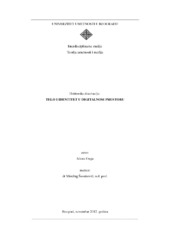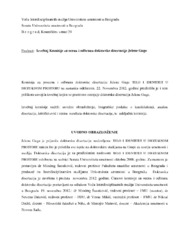| dc.contributor.advisor | Šuvaković, Miodrag | |
| dc.contributor.other | Daković, Nevena | |
| dc.contributor.other | Mikić, Vesna | |
| dc.contributor.other | Dedić, Nikola | |
| dc.contributor.other | Maravić, Manojlo | |
| dc.creator | Guga, Jelena | |
| dc.date.accessioned | 2018-05-29T11:49:10Z | |
| dc.date.available | 2018-05-29T11:49:10Z | |
| dc.date.issued | 2013-03-10 | |
| dc.date.submitted | 2012-12-03 | |
| dc.identifier.uri | http://eteze.arts.bg.ac.rs/handle/123456789/313 | |
| dc.description.abstract | Upotreba digitalnih tehnologija u svim aspektima svakodnevnog života otvorila je do sada nezamislive mogućnosti kao što su trenutni pristup informacijama, prisutnost na bilo kojoj tački planete, multipliciranje i menjanje identiteta, ali i reartikulacija i rekonstrukcija telesnosti. U cyberpunk književnosti, novomedijskim umetničkim praksama, sajber teorijama, SF filmovima i stripovima kao i naučnim istraživanjima, na različite načine prisutna je težnja ka napuštanju smrtnog fizičkog tela i pohranjivanju besmrtnog uma u digitalne baze podataka gde možemo biti šta i ko god poželimo. U odnosu na savremene tehnologije, biološko telo je često smatrano sekundarnim, zastarelim i kao takvo nije „osposobljeno“ da se nosi sa eksponencijalnom brzinom
tehnoloskog razvoja. Otud ne čudi što mnoga istraživanja, bilo stručna ili popularna, ostavljaju problem telesnosti po strani fokusirajući se više na pitanja identiteta, svesti i obestelovljenja u digitalnim svetovima. Stoga ću ovoj disertaciji pokušati da ukažem na i predstavim one teorije koje su fokusirane na pitanja telesnosti te ću kroz njih u diskusiju o novomedijskim fenomenima i njihovom uticaju na društvenu realnost uvesti i fizičko telo. U izradi disertacije poći ću od tvrdnje da bez fizičkog tela ne postoji ni virtuelno ni realno, a sa ciljem da upravo ukažem na značaj fizičkog tela u biološko-tehnološkim interfejsima, odnosno na načine na koje se menja uloga tela i telesnosti u okruženju opšte virtuelizacije, i samim tim na načine na koje te promene funkcije tela
utiču na ontološki opstanak čoveka kao biološke jedinke.
Problem konstruisanja identiteta i procesa identifikacije će kroz antiesencijalistički teorijski okvir biti praćene kroz dve različite, ali međusobno povezane faze evolucije globalnog umrežavanja, a to su Web 1.0 i Web 2.0 platforme. Dok su Web 1.0 platforme bile zasnovane na tekstualnoj reprezentaciji i igri identitetima u smislu da možemo biti sve ono što nismo u fizičkoj realnosti, Web 2.0 platforme zasnovane na društvenim mrežama transponuju identitete iz fizičke realnosti u domen virtuelnog. Ipak i ti realni identiteti u virtuelnom okruženju pokazuju se kao konstrukti, s obzirom da su zasnovani na selektivnoj reprezentaciji idealizovanog jastva. Povratnom spregom, to dalje pokreće pitanje ne samo kvaliteta uspostavljanja međuljudskih odnosa i komunikacije, već i načina na koje doživljavamo i definišemo sebe u fizičkom okruženju.
Brisanje granice između realnog i virtuelnog, privatnog i javnog, povlači jedno osnovno pitanje na koje će ovaj rad pokušati da odgovori, a to je: Šta znači biti čovek u današnjem svetu opšte ekranizacije i digitalizacije kada je prelivanje digitalnih interakcija u fizičko okruženje koje se ogleda u društvenim, kulturalnim i političkim aktivnostima, intervencijama, subverzijama, učinilo razdvajanje „realnog“ i „virtuelnog“ prostora kao i dualističko definisanje jastva zastarelim konceptom. Da li je u sajber svetu išta više virtuelno i da li sajber svet uopšte postoji ako se zbog „virtuelne“ aktivnosti kao što je, na primer, post na društvenoj mreži Fejsbuk, može izgubiti posao
ili je korporacija ta koja individuama diktira i definiše dozvoljenu manifestaciju digitalno
konstruisanog identiteta? Pored svega toga, ono što nam još uvek ipak pruža privid sigurnosti i diferencijacije realnog i virtuelnog jeste površina ekrana kao interfejs, odnosno granica gde prestaje realno a počinje virtuelno. Sve što je sa druge strane ekrana, poput iskrivljenog ogledala, dopušta nam da racionalizujemo i simplifikujemo granicu između onoga što nas definiše u fizičkoj realnosti i onoga kako sebe konstruišemo u onlajn interakcijama. Ali, šta kada se ekran, to crno ogledalo
razbije i kada naše telo kao interfejs postane odgovorno za to drugo Ja ili digitalni alter ego? S tim u vezi, posebna pažnja biće posvećena konceptu napuštanja ekrana i novim vrstama interfejsa koji reartikulišu odnose korporealnosti i virtuelnosti. Gestualni interfejsi kao novi miš, novi klik, ili novi dodir ekrana bez ekrana, kao i hologramske projekcije koji ulaze u svakodnevnu praksu, otvoriće mnogo dalekosežnija pitanja psihosomatske prirode: Ako na primer, jedni drugima budemo prisutni, odnosno teleprisutni putem holograma koje pak pokrećemo telesnom gestikulacijom, da li će to
značiti diferencijaciju stepena telesnosti u smislu valorizacije i hijerarhije telesnosti, i kako ćemo biti u stanju da odredimo šta je vrednije, prisutnije i stvarnije, projekcija ili realno telo? I da li će uopšte biti razlike između telesno manipulisane projekcije i samog tela koje već prolazi kroz procese kiborgizacije? Rečima Vilijema Gibsona, budućnost je već ovde, samo nije ravnomerno raspoređena. | en |
| dc.description.abstract | The ubiquitous use of digital technology in all aspects of daily life has opened up the unprecedented possibilities such as immediate access to information, (tele)presence at any place on the planet, multiplication and modification of identity, as well as rearticulation and reconstruction of embodiment. In cyberpunk literature, new media art practices, cyber theories, SF films and comic books, and scientific research, there is often a tendency to leave the mortal physical body behind in order to upload the immortal mind into the vast realm of the digital where one can be whatever or
whomever she/he wants. In relation to modern technology, the biological body is often regarded as obsolete for not being "equipped" to cope with the exponential speed of technological development. Hence it is not surprising that many studies leave aside the problem of embodiment by focusing more on the issues of identity, consciousness and disembodiment in digital worlds. Therefore, this dissertation will attempt to bring attention to and represent those theories that focus on embodiment
in technologically mediated environments, thus reintroducing the physical body into discussions of new media phenomena and the ways they affect social reality today. In this dissertation I will start from the hypothesis that without the physical body there is no virtual or real. The aim is to underline the significance of physical body in biotechnological interfaces and discuss and analyze the ways in which the role of body and embodiment changes in ubiquitous virtual environments, as well as to map the ways in which technology alters bodily functions thus affecting ontological
survival of humans as biological species.
The issues of constructing identities and identification processes will be observed through antiessentialist theoretical framework and mapped through two different but mutually intertwined phases in the evolution of global networks – Web 1.0 and Web 2.0 platforms. While Web 1.0 platforms were based on the textual representations and identity play allowing us to become everything we are not and can never be in the physical reality, Web 2.0 platforms that are specific for social networking delegate identities of physical reality in the virtual domain. However, presumed “real” identities manifest themselves as constructs in virtual environment since they are based on a selective representation of an idealized self. Through feedback loop, this phenomenon
further highlights the question of not only the quality of interpersonal relationships and
communication, but also the way that we perceive and define ourselves in the physical environment.
Dispersion of boundaries between real and virtual, private and public, entails a fundamental question that this dissertation will attempt to answer: What does it mean to be human in today's world of digitalization when the explosion of digital imagery and interactions into the physical environment has so profoundly affected social, cultural and political activities, interventions and subversions, turning both the distinction between "real" and "virtual" spaces and dualistic ways of defining the self into rather obsolete concepts. Is anything at all “virtual” in cyberspace, i.e. can cyberspace be defined as virtual at all when, for example, because of an activity such as posting on
Facebook one can lose a job or has to let corporation dictate and define what is and what is not appropriate in one’s digitally constructed identity? Nevertheless, we are still comforted by the illusion that our screen as interface separates the real and the virtual, functioning as the boundary or line marking the end of real and the beginning of virtual. Everything situated on the other side of the screen, like distorted mirror, allows us to rationalize and simplify existence of the boundary between what defines us in physical reality and what we are as constructs in online interactions. But what happens when the screen, that black mirror, breaks into pieces thus enabling the body as interface to become responsible for the other Self or the digital alter ego? In this regard, special
attention will be given to the concept of abandoning the screen and turning to the emerging new interfaces that rearticulate the relation between corporeality and virtuality. Gestural interfaces as a new mouse, a new click, or a new touch screen without a screen will, coupled up with holographic projections that have already found their way into the physical public spaces, open up a multitude of far-reaching questions of psychosomatic nature: If, for example, we are present/telepresent to one another via holograms animated via corporeal gestures, would it mean the differentiation of degree
of corporeality in terms of valorization and hierarchy of embodiment? How will we be able to determine what is more valuable, more present and real – projection or materiality of the body? And finally, will there be any difference at all between gesturally manipulated projection and the real body that is already deeply caught in the process of cyborgization? In William Gibson’s words, the future is already here - it's just not very evenly distributed. | en |
| dc.language.iso | sc | en |
| dc.publisher | Универзитет уметности у Београду, Интердисциплинарне студије Универзитета уметности | sr |
| dc.source | Интердисциплинарне студије Универзитета уметности | sr |
| dc.title | TELO I IDENTITET U DIGITALNOM PROSTORU | en |
| dc.type | doctoralThesis | en |
| dcterms.abstract | Шуваковић, Миодраг; Маравић, Манојло; Даковић, Невена; Микић, Весна; Дедић, Никола; Гуга, Јелена; | |


